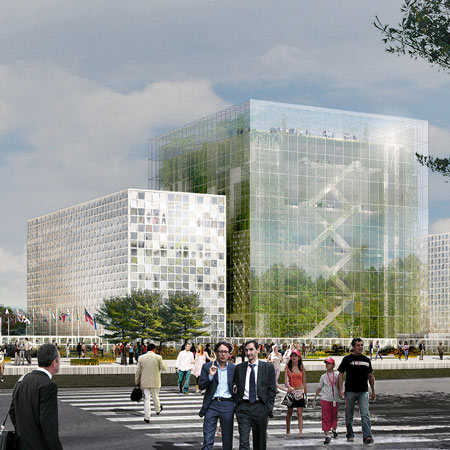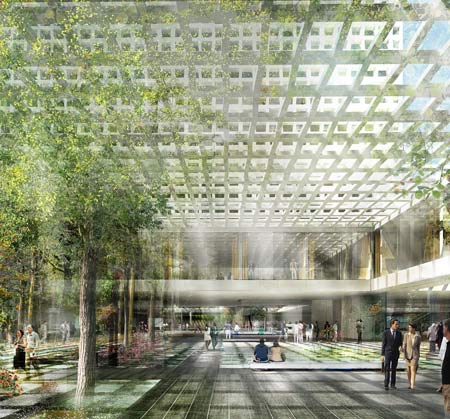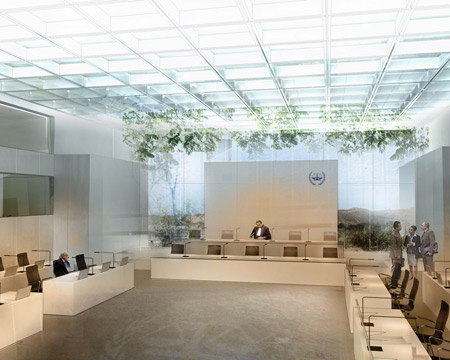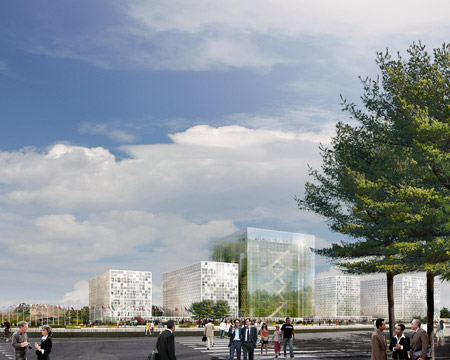
International Criminal Court by Schmidt Hammer Lassen
Danish studio Schmidt Hammer Lassen Architects have won a competition to design the International Criminal Court in The Hague, Netherlands.

Located in dunes close to the sea, the project will consist of square towers clad in a composite material normally applied to race cars and windmills.

Gardens will extend into the main tower, including plants from each of the International Criminal Court member states.

Here's some more information from the architects:
Schmidt Hammer Lassen Architects’ design wins the competition for the International Criminal Court in The Hague
After years of accommodation in temporary premises, the International Criminal Court (ICC) in The Hague has revealed its design for new permanent headquarters by Schmidt Hammer Lassen Architects (SHL). The Danish office was selected in a prestigious architectural design competition with a twenty strong international shortlist including David Chipperfield, Mecanoo Architecten, OMA/Search, Ingenhoven, Wiel Arets, and Kengo Kuma & Associates.
“To the victims, to their families and to the world, the ICC building must communicate respect, trust and hope. This building cannot be anonymous; it must have the courage to express the values and the credibility of the ICC,” says Bjarne Hammer, Co-Founding Partner and Creative Director of Schmidt Hammer Lassen Architects. He continues: “The building is designed as an abstract and informal sculpture in the landscape. This way, it becomes a backdrop for the ICC to communicate trust, hope, and most importantly, faith in justice and fairness.”
Located close to the North Sea, the new Court is placed between nature and city, set in the rolling dune landscape at the edge of The Hague. The main concept is the sculptural arrangement of buildings in the landscape and the design of a landmark that conveys the eminence and authority of the ICC while at the same time relating to a human scale. Schmidt Hammer Lassen´s winning design complies with a complex brief and captures the spirit of the ICC. The overall building form can be seen as an undulating composition of volumes on the horizon, reminiscent of the dune landscape. “It was evident that connecting the dune landscape with the edge of the city had a striking potential. By designing a compact building with a small footprint, we propose to return the landscape to the city,” says Bjarne Hammer.
According to the Architectural Jury, the design provides the ICC with a sculptural composition of square towers. The Jury quoted this approach as: “a very impressive and interesting architectural gesture and a great contribution to the city with an attractive integration into the landscape. This applies also for the idea of 'moving down' to the Court through the spacious staircase. The big and sharp incision in the landscape and the lower ground floor are very interesting elements. The inner atmosphere was confirmed as user-friendly, especially the spacious ground floor with beautiful daylight from above. This ground floor can be seen as an inner private park area which facilitates the interaction between all the ICC employees in a very pleasant and positive way.”
By making a sharp incision into the ground the building complex forms a contrast to the surrounding dune landscape. The architectural idea is to continue the gardens in the ground floor (parterre) level of the building, as a cladding of the Court Tower.
“Gardens have always existed as part of all cultures and all religions. With flowers and plants from each of the 110 ICC member countries, the parterre gardens rise up as a green landmark and a symbol of unity, regardless of nationality and culture,” explains Bjarne Hammer.
Environmental sustainability is a key criterion in terms of the building’s footprint and the selection of building materials. The facades of the office buildings are clad in a composite material selected for its suitability to the windy and salty local climate, ease of maintenance and security performance. The material is normally used in the bodywork of professional race cars and in the cladding of windmills due to its durability. The design has at this stage been assessed as BREEAM Excellent.
Facts about the International Criminal Court (ICC)
The International Criminal Court (ICC), governed by the Rome Statute, is the first permanent, treaty-based, international criminal court established to end impunity for perpetrators of the most serious crimes of concern to the international community. The Court is mandated to prosecute crimes against humanity, war crimes and genocide, when national courts are unable or unwilling to do so. As of 1 March 2010 the Rome Treaty has been ratified by 110 States. The ICC is an independent international organisation, and is not part of the United Nations system. The legal basis for the organisation is the Rome Statute adopted in 1998. Although the Court’s expenses are funded primarily by States Parties, it also receives voluntary contributions from governments, international organisations, individuals, corporations and other entities.
Client: The International Criminal Court (ICC)
Area: 46,000 m2, up till 1,200 work places
Construction sum: €190 million ex. VAT
Competition: 2008-2010, restricted international competition with a total of 171 applications
Consultants
Engineer:
Royal Haskoning Nederland B.V.
Esbensen - Consulting Engineers AS
Interior design and art: Bosch & Fjord in collaboration with schmidt hammer lassen architects.